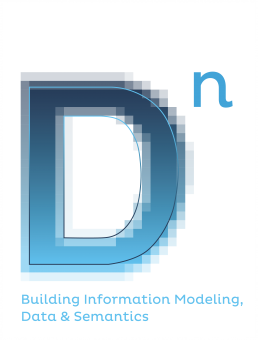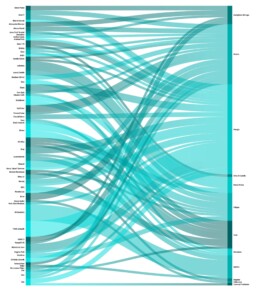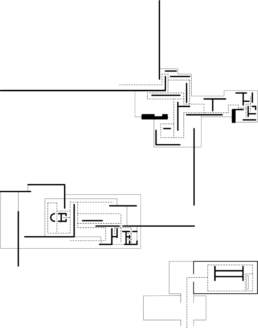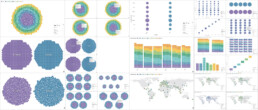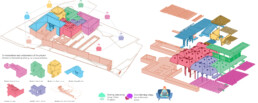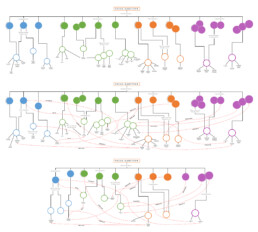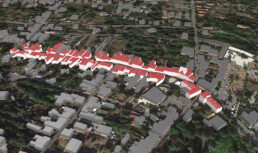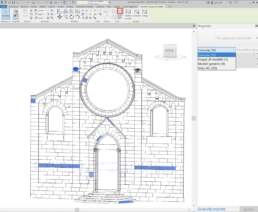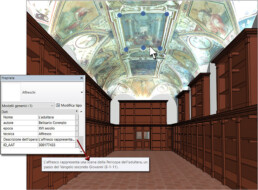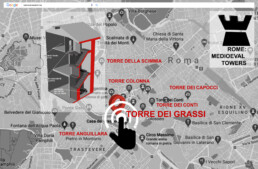Accessible informations. Visualizing data in the age of big data, open data and open tools
ABSTRACT
This article discusses the potential of data visualization in the era of Big Data, highlighting how the great availability of open data and open tools strengthen the need for a designer-based scientific approach capable of going beyond the current affirmation of user-generated content (UGC).
1) Enrico Cicalò, 2) Valeria Menchetelli
1) Università di Sassari, 2) Università di Perugia
From type to diagram: data representation as heuristic tool for architectural design
ABSTRACT
In the field of architectural design, representation is a growingly fundamental tool for the conception process. The paper attempts to enquire about the relationship between type and diagram, both often regarded as mere simplifications of reality, starting from the observation that diagram is increasingly considered as a tool able to explicit the conception process in architecture.
Michela Barosio, Rossella Gugliotta
Politecnico di Torino I DAD
Graphic visualization and new ways to represent data
ABSTRACT
Visualization, infographic, information graphics, etc. Each book or reference on visual communication uses these terms with different meanings. The term visualization or representation seems to be the umbrella term: any type of visual elaboration of information intended to enable communication, analysis, discovery, exploration, artistic purposes. There are more and more applications of a scientific nature that are particular types of visualizations, customizable according to the needs of each observer. Some are designed to convey narratives on the basis of different sets of (infographic) information, others are designed mainly to allow exploration (data visualizations for subsequent in-depth analysis). Many authors have classified data processing methods that help to choose the best ways to represent them and there is no lack of, and continue to grow in number, online projects specifically dedicated to data processing to generate information: tableau.com, datawrapper.de, flourish.studio, rawgraphs.io, plotdb.com, to name a few. How to create, share and consult data is the theme of the proposed contribution, investigated through examples of graphic representation that give “information” starting from what is “data”.
Maurizio Marco Bocconcino, Mariapaola Vozzola,
Politecnico di Torino, DISEG - Dipartimento di Ingegneria Strutturale, Edile e Geotecnica
H-BIM: information flows and data digitization processes
ABSTRACT
The contribution presents some methodological research experiences conducted by the research group of the DAda-LAB Laboratory, of the University of Pavia, on the possibility of using standard protocols such as IFC and shared models, through the use of a common language for facilitating the exchange of information.
Anna Dell’Amico
DICAr-Dipartimento di Ingegneria Civile e Architettura, Università degli studi di Pavia
Knowledge representation through cognitive maps to foster collaborative research
ABSTRACT
Research increasingly makes use of multidisciplinary contributions to achieve valid and shared results. The synergy between different areas of knowledge is greater the clearer the language of sharing. Cognitive maps, an instrument belonging in general to the sphere of cognitive sciences, propose a language for sharing knowledge using graphic codes for the synthesis of concepts. This article proposes a revision of the “grammar” generally used for the modelling of cognitive maps, aiming at a representation of knowledge capable of facilitating the access to the information produced.
The prototype map was then applied for content sharing as part of the PRIN TECH-START project, in which a seminar was held involving experts in conservation, representation of architecture, representation of knowledge, technical physics, computer science, IoT, evaluation and estimation, and the technology of architecture.
Different experts were asked to express their opinion on the barriers to the use of new enabling technologies and smart environments as a support to the evolution of processes for the management, conservation, documentation, predictive control, non-destructive diagnostics and energy improvement of historical buildings.
The joint use of these tools produces complex heterogeneous data that require an interdisciplinary approach, involving very different actors with the common need to share their knowledge.
1) Elena Gigliarelli, Filippo Calcerano, Michele Calvano, Stefano Cursi, Leo Lorenzi, Letizia Martinelli,
2) Maurizio Sibilla
1) Institute of Heritage Science, National Research Council of Italy, 2) School of the built environment, Oxford Brookes University
From OpenData to city models: an Anti-Fragile approach for City Information Modeling
ABSTRACT
The research investigates the application of the concept of Antifragility in City Information Modeling (CIM). In accordance with the Digital Twin concept, we propose a CIM model that increases the quantity and quality of data with contributions from volunteer mappers before and during crisis scenarios.
Federico Mario La Russa & Cettina Santagati
Università degli Studi di Catania - DICAR
Reflections on the use of HBIM from experiments on the field
ABSTRACT
In recent years, many research studies have demonstrated the potential application of BIM systems in the field of conservation of historic buildings, promoting the creation of a new methodology: the Historical Heritage and Building Information Modeling. The HBIM, starting from the survey as the basis of building knowledge, has the advantage of allowing the storage of a lot of information in one model, the integration of highly accurate three-dimensional surveys, planning of conservation and the calculation of related costs, data mining for the ordinary maintenance and in general to the building heritage management.
Heterogeneous information such as reliefs and three-dimensional models, documentary sources, cartographic and iconographic, textual information may be merged into a single database, facilitating the sharing and management at multiple levels and by multiple operators.
The proposed trial provides an opportunity to reflect on HBIM role and to try to understand, analyzing the difficulties, limitations and the potential that the system can offer in the field of conservation. Starting from the case of BIM realized for the fine facade of the Abbey of San Matteo in Genoa, will be analyzed key aspects in the management of the historical heritage, especially in light of the scientific literature related to the use of HBIM.
1) Carlo Battini, 2) Rita Vecchiattini
1) DICCA - Department of Civil, Chemical and Environmental Engineering, Università degli Studi di Genova
2) dAD - Department of Architecture and Design, Università degli Studi di Genova
Documentation of frescoed surfaces in HBIM models
ABSTRACT
This paper presents a possible approach to document and transmit – in HBIM systems – graphics and textual data relating frescoes that often characterize the wall surfaces of historical artifacts. The study was conducted on the ancient Benedictine monastery of SS Severino and Sossio, Naples.
Simona Scandurra
Politecnico di Milano
Graphical communication of the ‘Torre dei Grassi’ at the ‘Portico d’Ottavia’ in Rome
ABSTRACT
This article investigates the different ways in which an architectural good of great historical and cultural value such as the ‘Torre dei Grassi’ in Rome can be documented and communicated. Recording the state of conservation of a cultural good is particularly important for preserving its value.
Giulia Pettoello
DSRDA Department of History, Drawing and Restoration of Architecture. Sapienza University of Rome.
An algorithmic information model (AIM) for the map of decay: the Church of San Giuliano
ABSTRACT
In the last decade, the discipline of architectural representation has investigated the possibilities offered by Building Information Modelling (BIM) methodologies applied to historical heritage (H-BIM). In recent years, the emerging use of Visual Programming Language (VPL) based software is bridging the gap between three-dimensional modelling and information modelling through the use of algorithms that can be customized and made public also thanks to interoperable data formats.
The study presents a workflow developed in VPL environment to create a semi-automatic degradation map. The proposed machine learning algorithms allow generating new components starting from the acquisition data of a survey and the subsequent data processing. The proposed solution offers an innovative solution for the classification and semi-automatic creation of degradation elements that provides the association between geometries derived from 3D mesh and the information apparatus associated with them.
Elisabetta Caterina Giovannini, Andrea Tomalini
Department of Architecture and Design - DAD, Politecnico di Torino
